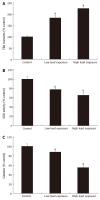Lead exposure increases oxidative stress in the gastric mucosa of HCl/ethanol-exposed rats
- PMID: 17876879
- PMCID: PMC4434643
- DOI: 10.3748/wjg.v13.i38.5121
Lead exposure increases oxidative stress in the gastric mucosa of HCl/ethanol-exposed rats
Abstract
Aim: To investigate the role of reactive oxygen species in the ulcer-aggravating effect of lead in albino rats.
Methods: Albino Wistar rats were randomly divided into three groups and treated orally with 100 mg/L (low dose) or 5000 mg/L (high dose) of lead acetate for 15 wk. A third group received saline and served as control. At the end of wk 15, colorimetric assays were applied to determine the concentrations of total protein and nitrite, the activities of the oxidative enzymes catalase and superoxide dismutase, and lipid peroxidation in homogenized gastric mucosal samples.
Results: Exposure of rats to lead significantly increased the gastric mucosal damage caused by acidified ethanol. Although the basal gastric acid secretory rate was not significantly altered, the maximal response of the stomach to histamine was significantly higher in the lead-exposed animals than in the unexposed control group. Exposure to low and high levels of lead significantly increased gastric lipid peroxidation to 183.2%+/-12.7% and 226.1%+/-6.8% of control values respectively (P<0.0). On the other hand, lead exposure significantly decreased catalase and superoxide dismutase (SOD) activities and the amount of nitrite in gastric mucosal samples.
Conclusion: Lead increases the formation of gastric ulcers by interfering with the oxidative metabolism in the stomach.
Figures



Similar articles
-
Anti-ulcer role of herbomineral Siddha drug - Thamira parpam on experimentally induced gastric mucosal damage in rats.Hum Exp Toxicol. 2010 Mar;29(3):161-73. doi: 10.1177/0960327109357217. Epub 2010 Jan 5. Hum Exp Toxicol. 2010. PMID: 20051456
-
Attenuation of indomethacin- and HCl/ethanol-induced oxidative gastric mucosa damage in rats by kolaviron, a natural biflavonoid of Garcinia kola seed.Phytother Res. 2006 Jan;20(1):14-20. doi: 10.1002/ptr.1793. Phytother Res. 2006. PMID: 16397915
-
Ulcer Prevention Effect Of 3,4,5-Tihydroxy-N0-[(2-Methyl-1H-Indol-3yl)Methylidene]Benzohydrazide In HCl/Ethanol-Induced Gastric Mucosal Damage In Rats.Int J Med Sci. 2017 Oct 15;14(13):1317-1326. doi: 10.7150/ijms.20984. eCollection 2017. Int J Med Sci. 2017. PMID: 29200945 Free PMC article.
-
The impact of dehydroepiandrosterone on indomethacin-induced gastric lesions in rats.Acta Physiol Hung. 2014 Mar;101(1):77-87. doi: 10.1556/APhysiol.101.2014.1.9. Acta Physiol Hung. 2014. PMID: 24631796
-
The dual modulatory effect of folic acid supplementation on indomethacin-induced gastropathy in the rat.Turk J Gastroenterol. 2012;23(6):639-45. doi: 10.4318/tjg.2012.0423. Turk J Gastroenterol. 2012. PMID: 23794298
Cited by
-
Oxidative stress responses as a marker of toxicity in mice exposed to polluted groundwater from an automobile junk market in South-Western Nigeria.Cell Stress Chaperones. 2022 Nov;27(6):685-702. doi: 10.1007/s12192-022-01305-w. Epub 2022 Nov 2. Cell Stress Chaperones. 2022. PMID: 36322346 Free PMC article.
-
Cardiovascular and renal oxidative stress-mediated toxicities associated with bisphenol-A exposures are mitigated by Curcuma longa in rats.Avicenna J Phytomed. 2024 Mar-Apr;14(2):202-214. doi: 10.22038/AJP.2023.23367. Avicenna J Phytomed. 2024. PMID: 38966628 Free PMC article.
-
Oxidative stress changes observed in selected organs of African giant rats (Cricetomys gambianus) exposed to sodium metavanadate.Int J Vet Sci Med. 2018 Mar 19;6(1):80-89. doi: 10.1016/j.ijvsm.2018.03.004. eCollection 2018 Jun. Int J Vet Sci Med. 2018. PMID: 30255083 Free PMC article.
-
Kolaviron attenuated arsenic acid induced-cardiorenal dysfunction via regulation of ROS, C-reactive proteins (CRP), cardiac troponin I (CTnI) and BCL2.J Tradit Complement Med. 2017 Dec 7;8(3):396-409. doi: 10.1016/j.jtcme.2017.05.003. eCollection 2018 Jul. J Tradit Complement Med. 2017. PMID: 29992111 Free PMC article.
-
Lead Toxicity From a Swallowed Fishing Sinker: A Case Report.JPGN Rep. 2021 Jun 25;2(3):e084. doi: 10.1097/PG9.0000000000000084. eCollection 2021 Aug. JPGN Rep. 2021. PMID: 37205941 Free PMC article.
References
-
- Perry MA, Wadhwa S, Parks DA, Pickard W, Granger DN. Role of oxygen radicals in ischemia-induced lesions in the cat stomach. Gastroenterology. 1986;90:362–367. - PubMed
-
- Schmassmann A, Stettler C, Poulsom R, Tarasova N, Hirschi C, Flogerzi B, Matsumoto K, Nakamura T, Halter F. Roles of hepatocyte growth factor and its receptor Met during gastric ulcer healing in rats. Gastroenterology. 1997;113:1858–1872. - PubMed
-
- Yamaguchi N, Kakizoe T. Synergistic interaction between Helicobacter pylori gastritis and diet in gastric cancer. Lancet Oncol. 2001;2:88–94. - PubMed
-
- Janulaityte-Günther D, Günther T, Pavilonis A, Kupcinskas L. What Bizzozero never could imagine - Helicobacter pylori today and tomorrow. Medicina (Kaunas) 2003;39:542–549. - PubMed
-
- Rostom A, Wells G, Tugwell P, Welch V, Dube C, McGowan J. Prevention of chronic NSAID induced upper gastrointestinal toxicity. Cochrane Database Syst Rev. 2000:CD002296. - PubMed
Publication types
MeSH terms
Substances
LinkOut - more resources
Full Text Sources

